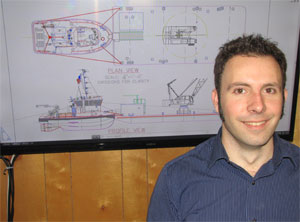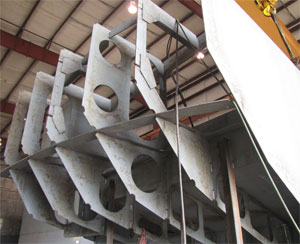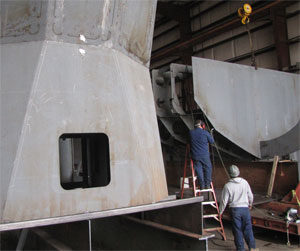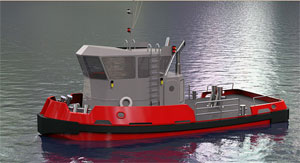One of the most unusual boat-handling tasks in the Great Lakes region is the annual creation and dismantling of the massive ice boom that protects the Niagara Power Project.
The same two tugboats responsible for that cold-weather job in Buffalo, N.Y., have now put in a combined 80-plus years of service. In recognition of the vessels’ condition and the fact that they have exceeded their service lives, the New York Power Authority (NYPA) last year hired Great Lakes Shipyard to build a pair of replacement tugs.
The first of the new boats, Daniel Joncaire II, will be delivered in September from the Cleveland yard. NYPA is using the opportunity to add modern improvements that will enhance the pair’s ability to do their work effectively and safely. They will be ice-strengthened, with elevated pilothouses and modified workstations for better visibility.
The new 940-hp vessels presented designer Bristol Harbor Group Inc. and the builders with challenges inherent in fitting all the stoutness and equipment features a 21st-century customer would want into a pint-sized package. William Jordan, Bristol Harbor’s senior naval architect, said the 45-foot-long convention-drive tugs are reinforced to sail through seasonal ice at the eastern end of Lake Erie where it empties into the Niagara River, upstream from two hydroelectric plants.
“It was a process to meld the essential features of the existing fleet into a new multi-boat design they are transitioning into,” Jordan said. “Their primary task is to lay out and ultimately retrieve the ice boom to create an ice dam to prevent ice from getting into the (power plants’) water intakes.”
The wheelhouses on the two existing boats — Daniel Joncaire and Breaker — are at main-deck level. On the new twin-screw boats, the captain will work about 15 feet, six inches above the waterline, said Jonathan Leivo, director of engineering at Great Lakes Shipyard.
Five years ago, Bristol Harbor and Great Lakes cooperated to build a new barge for NYPA’s ice-boom duty, Havasu II. The 80-foot barge, which replaced the previous barge Havasu, is equipped with an 80-ton-capacity Terex HP80 pedestal-mounted lattice boom crane. The same organizations teamed up for the $5 million tug contract.
Daniel Joncaire II’s job will be to push the crane barge, which lifts buoy barrels and boom sections, while Breaker supports the job by towing the sections to the barge. The elevated wheelhouse will help the captain to see beyond the crane barge, greatly aiding situational awareness and close-quarters maneuvering.
 |
|
Jonathan Leivo, director of engineering at Great Lakes Shipyard, with drawings of the tug-barge configuration for Daniel Joncaire II. |
|
Dom Yanchunas |
“The house is kind of monstrous compared to the rest of the vessel,” said Jordan. That’s in contrast to the incumbent boats, each of which is a “single-deck vessel with a house on that deck, so the captain is standing on the main deck level and really doesn’t have any kind of elevated view,” he said.
In addition to installing the ice boom segments each December and removing them in the spring, the NYPA fleet maintains the 8,800-foot-long boom during the winter and participates in other marine construction projects near the Niagara River power stations.
“The vessels will be specially reinforced for operations in seasonal ice,” said Michael Mitchell, NYPA’s project manager. “They employ heavy stems for light icebreaking and shell reinforcement along the ice belt.”
The project managers did their best to design the boats to comply with the still-unreleased U.S. Coast Guard Subchapter M requirements, which eventually will lead to a national inspection regime for towboats. They applied lessons learned from contemporary ice-class operations elsewhere.
“It’s based on — but not totally in compliance with — the requirements of ABS ice-class D0, so it’s designed for very light ice, relatively speaking,” Jordan said of Daniel Joncaire II. “In the bow we have basically doubled the framing from what you would see in a non-ice-class.”
In the ice-strengthened sections, half-inch-thick steel is used, compared with three-eighths-inch steel elsewhere, Leivo said. Other framing and the transom are beefed up too, all with Lake Erie ice in mind.
“Their primary concern was the bow, but in this case we (strengthened) the stern as well, because they back into the stuff too — mostly when they move the barge and crane out,” Jordan said.
To promote safe operation, not only is the wheelhouse elevated but it also includes multiple conning locations, which the pilot can choose depending on which provides the best vantage point during various maneuvers.
 |
|
A hull section of Daniel Joncaire II at Great Lakes Shipyard in April. |
|
Dom Yanchunas |
“This boat will be used to push the barge,” Leivo said. “There are three steering stations in the wheelhouse – one all the way to port, one all the way to starboard and one exactly on the centerline. It’s maximum visibility.”
The 380-square-foot aft work deck facilitates the ice boom connections. The work deck “is really midships-aft, so it’s about half the boat’s stern working area,” Leivo said.
“One tug brings the ice boom strings, and the other tug pushes the barge from location to location,” he said. “They use the pedestal-mounted crane to move the boom. That’s how they connect to the anchoring points.”
The ice boom is engineered to accelerate the formation of a natural ice arch that forms near the head of the Niagara River at the Lake Erie outlet, and then to stabilize the arch. The idea is to mitigate the severity of ice runs from the lake, reducing the threat of ice blockages in the river. This protects the water flow into the hydro plants and lessens shoreline property flooding and damage to docks.
“The process begins by towing a 500-foot span from the onshore storage site to the water’s edge, where a tagline from the barge is connected to one end of the span,” said NYPA’s project engineer, Patricia Lombardi. “At the opposite end, another 500-foot span is attached. The end of the span at the barge is transferred to the tugboat and the 1,000-foot composite section is towed out farther into the water.
“The 1,000-foot section is towed across the Buffalo Outer Harbor and secured with cables to the outer breakwall.”
That process is repeated until all spans are secured to the breakwall. Then Breaker joins in, and together the two tugs install the spans into the lake.
“First we remove a 1,000-foot ice boom section from the outer breakwall and tow the section to the work barge/tugboat that is secured at the junction plate,” Lombardi said.
 |
|
A welding crew is at work on the hull section, which is next to the vessel’s pilothouse structure. |
|
Dom Yanchunas |
“The towing end of this section is transferred to the barge and subsequently moves to the center of the trailing 1,000-foot section and pushes the section to the adjacent junction plate,” she said. “The tow ends are connected to the junction plate and the procedure continues until all spans are installed.”
The boom stays in place all winter, protecting the facility until the spring thaw reduces the ice coverage to a predetermined level. The boats remove the boom sections in the reverse order of installation.
On the new tugs, a pair of Caterpillar C18 engines, at 470 hp apiece, will spin the two 46-inch props. The auxiliary generator is a Cat C4.4. Some components — including the switchboard, silencers and piping — were a challenge to fit into the 45-foot design, Leivo said.
“They wanted duplicate pipe coolers in the hull,” Jordan said. “We have customized the box coolers to make them fit into what we have. … We built a sea chest that has slots in the top and bottom, so they are out of harm’s way from the ice and debris.”
The NYPA tugs are among the smallest that Bristol Harbor has designed, according to Jordan. “We’ve kind of scaled down what we have done before for 85-footers to a 45-footer,” he said. “Miniaturizing things and making it work has been a challenge from day one.”
There is a two-year gap between delivery of Daniel Joncaire II and Breaker’s replacement, which NYPA said will be named Breaker II and won’t be built until 2017. Leivo said NYPA intends observe the new Joncaire boat’s performance first.
“They want to run it for a year and see if there are any tweaks they want to make before (Breaker II) starts production,” Leivo said.
Bristol Harbor was contracted by NYPA to develop the contract design documents for the tugboats, as it did for the new barge in 2010. The Rhode Island-based marine design firm assisted NYPA during the bid process and is the power authority’s on-site representative at Great Lakes. Monitoring quality assurance and certification has given Bristol Harbor a keen insight into the importance of the two tugboats, whose work enhances the quality of life for New Yorkers.
The ice boom also protects Ontario Power Generation’s Sir Adam Beck hydroelectric generating stations.

